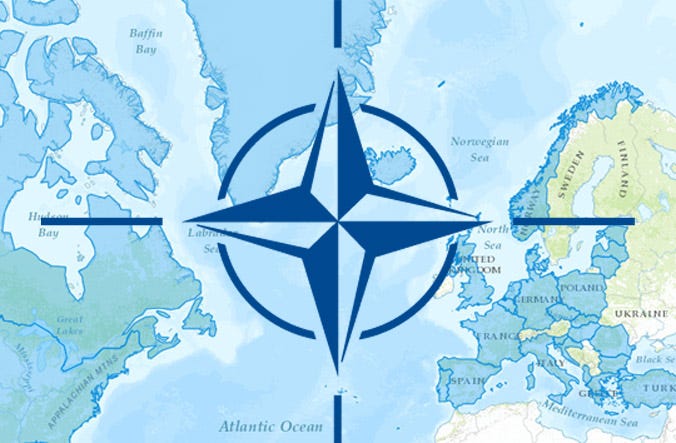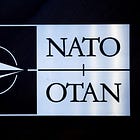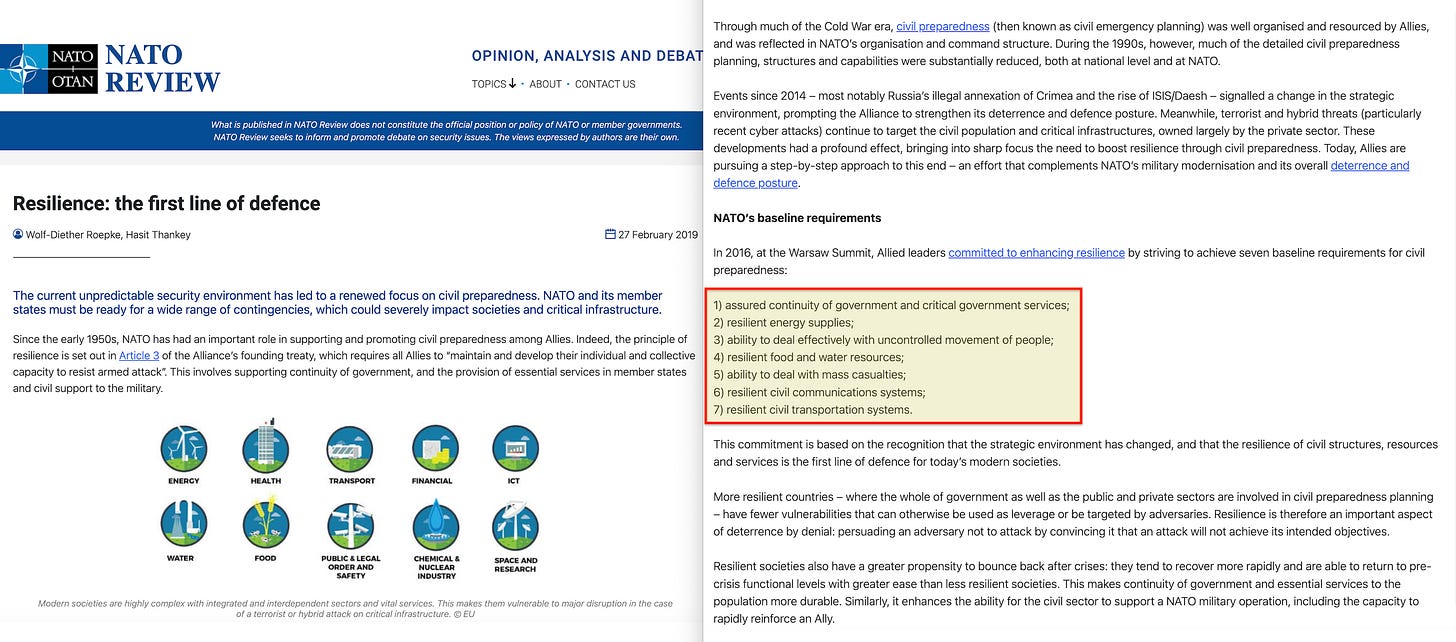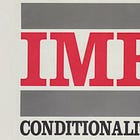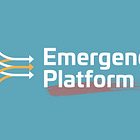The previous essays showed how international financial institutions use conditional economics to control countries through staged payments and digital oversight, how computer predictions drive policy decisions, how emergency platforms can soon override sovereignty, and how this system spreads globally through routine aid programs.
But there's another track running parallel to the economic one: security alliances that do the same thing through different mechanisms.
From Defense Pact to Performance Contract
NATO started simple in 1949: if one member gets attacked, everyone fights back. Article 5 collective defense, clear military purpose, democratic oversight. But by 1956, that wasn't enough anymore.
The Committee of Three report changed everything. Faced with Cold War competition that went beyond traditional battles, NATO's foreign ministers decided that military alliance alone wouldn't work. The report argued that NATO's survival required expanding into ‘non-military cooperation’ — specifically political consultation and economic coordination as essential components of collective security.
This was the same conceptual breakthrough previously documented: redefine the core concept to include ‘all determinants that affect’ it, then use that expanded definition to justify intervention anywhere. NATO redefined ‘security’ to include political stability and economic resilience, among other domains, fundamentally expanding the alliance's scope of concern.
The key innovation was subtle but revolutionary: NATO members should engage in ‘advance consultation’ before taking actions that might affect alliance interests. Consultation sounds voluntary and democratic, but in practice, consultation functions like a soft veto system where alliance concerns could override national preferences.
The Technical Takeover
What started as ‘let's talk first’ evolved into ‘let's standardise everything’. NATO developed thousands of Standardisation Agreements1 (STANAGs) covering operational, procedural, and technical domains. These became de facto requirements for alliance participation through interoperability demands.
Think of STANAGs like the international standards described in conditional economics. Just as countries need EU-compatible sustainability standards to access European markets, NATO members need STANAG-compatible systems to participate in alliance operations. No compatibility, no genuine alliance membership.
The process works through technical necessity. Want to communicate with other NATO forces? Your radio systems must meet STANAG standards2. Want to share ammunition? Your weapons must be compatible3. Want joint training4? Your procedures must align with NATO doctrine5.
Each standard seems purely technical, but together they create comprehensive requirements for how militaries — and eventually governments — must operate. Countries retain nominal sovereignty while their actual options get constrained by thousands of compatibility requirements embedded in alliance participation.
The Seven Baseline Requirements
By 2016, NATO had formalised what resilience actually means through seven Baseline Requirements that each member must meet6, established at the Warsaw Summit7. These work exactly like the Key Performance Indicators described in conditional economics — measurable targets that countries must hit to maintain good standing.
The seven requirements cover8:
Assured continuity of government and critical government services9
Resilient energy supplies10
Ability to deal effectively with uncontrolled population movements11
Resilient food and water resources12
Ability to deal with mass casualties13
Resilient civil communications systems14
Resilient transportation systems15
Do realise what’s happened here: NATO's security requirements now cover energy policy, immigration policy, food systems, healthcare capacity, communications infrastructure, and transportation networks. These are comprehensive domestic governance areas that NATO can now assess, monitor, and make recommendations about.
Countries get regularly reviewed on their resilience performance through national baseline assessments, just like countries get reviewed on their economic performance by international financial institutions. NATO doesn't directly withhold military protection for poor resilience scores, but it creates peer pressure, capability gaps, and reputational costs that push countries toward compliance.
Civil Preparedness Becomes Digital Governance
NATO's civil preparedness requirements increasingly mirror the six-component digital governance system previously documented:
Component 1 (Standards/Accreditation) → NATO resilience baselines and STANAGs determine what counts as adequate preparation.
Component 2 (Conditional Access/Funding) → Alliance capabilities, funding, and support (capabilities, funding, access) flow to countries that meet resilience requirements.
Component 3 (Digital Identity) → Interoperable communication systems and information sharing require compatible digital infrastructure.
Component 4 (Traceability/Audits) → Defense procurement increasingly requires transparent, auditable spending tracked through digital systems.
Component 5 (Data/Monitoring) → Intelligence sharing, threat assessment, and resilience monitoring create comprehensive surveillance requirements.
Component 6 (Procurement Integration) → Defense procurement standards cascade through entire economies, making civilian suppliers adopt NATO-compatible systems.
The result is that NATO's technical requirements for alliance participation create the same comprehensive oversight mechanisms as international financial institution lending, just through different pathways.
Two Tracks, Same Destination
The economic track (International Monetary Fund/World Bank) and security track (NATO) create parallel systems of conditional sovereignty that increasingly converge:
Standards Setting: International Financial Institutions use sustainability criteria and governance benchmarks16; NATO uses STANAGs and resilience baselines17.
Performance Monitoring: International Financial Institutions use structural benchmarks and disbursement-linked indicators18; NATO uses capability reviews and resilience assessments19.
Digital Infrastructure: International Financial Institutions require e-procurement and digital identity systems20; NATO requires interoperable communications and data sharing21.
Emergency Protocols: International Financial Institutions activate through UN Emergency Platform22; NATO activates through Article 5 and crisis response procedures23.
Compliance Enforcement: International Financial Institutions withhold financing24; NATO creates capability gaps and alliance marginalisation through readiness shortfalls and exercise participation impacts25.
Lock-in Effects: Both create dependencies (financial markets vs. security integration) that make exit economically and strategically prohibitive26.
The shift from treaties to dashboards isn't only economic; in security, consultation became standards, and standards were audited.
Ukraine: Where Both Tracks Converge
Ukraine shows both systems operating simultaneously. The country faces International Monetary Fund structural benchmarks27, World Bank disbursement-linked indicators28, EU accession requirements29, and NATO integration standards30 all at once.
Ukraine's digital governance requirements serve both tracks: e-procurement platforms meet World Bank transparency requirements and NATO interoperability standards. Digital identity systems enable both financial monitoring and alliance information sharing. Resilience planning addresses both economic stability and security preparedness.
War made both tracks visible in one place, showing how economic conditional sovereignty and security conditional sovereignty work together to create comprehensive external oversight justified by crisis necessity.
The Performance License System
Modern sovereignty works like a license that gets renewed through continuous performance evaluation across multiple domains:
Economic License: Maintained through International Monetary Fund reviews, World Bank assessments, and market access requirements.
Security License: Maintained through NATO capability reviews, resilience assessments, and increasingly alliance integration requirements.
Legal License: Maintained through EU compliance monitoring, international court decisions, and treaty obligations.
Emergency License: Subject to suspension during declared crises when emergency platforms activate override authority.
Countries can make domestic policy choices, but only within parameters established by their performance against externally managed standards. Democratic choice continues within boundaries that can shift rapidly based on assessment updates that bypass electoral processes.
The Choice Point
Understanding NATO's role in conditional sovereignty reveals how comprehensively national autonomy has been restructured:
Technical Complexity: Countries face thousands of compatibility requirements across economic and security domains that create dense webs of external dependencies.
Assessment Proliferation: Regular performance reviews across multiple institutions create continuous external oversight that can trigger consequences in interconnected domains31.
Crisis Activation: Both economic and security emergency mechanisms can rapidly expand oversight authority during declared shocks.
Democratic Bypass: Technical standards and performance requirements reshape governance options faster than democratic institutions can evaluate or respond to changes.
Lock-in Momentum: Each track reinforces the other through overlapping requirements and shared infrastructure needs.
This architecture does deliver coordination benefits and addresses global challenges requiring international cooperation. The question is whether effective coordination requires the comprehensive performance-based oversight currently operating through both economic and security institutions.
NATO's evolution from defense pact to performance monitoring system parallels the transformation of international financial institutions from emergency lenders to comprehensive governance overseers. Both now define the terms under which sovereignty can be exercised rather than just providing services to sovereign states.
If rapid coordination and technical effectiveness is valued, this dual-track system does deliver results. If we instead value democratic control and national self-determination, we need explicit safeguards on how performance standards get set, who monitors compliance, and how ‘temporary’ emergency authorities are deactivated. Yet, should the crisis be permanent, and the enemy lasting…
Both tracks are fully operational, increasingly coordinated, and backed by activation protocols that can rapidly expand oversight authority during the next declared crisis, economic or military — the infrastructure is in place.
What began as collective defense in 1949 and emergency lending in 1944 has evolved into comprehensive performance monitoring that defines the boundaries within which sovereignty can be exercised.
But then, Moynihan practically told us something wasn’t quite right by calling for NATO to run global surveillance on the environment already back in 196932.


